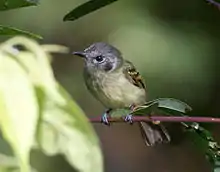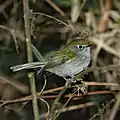| Pogonotriccus | |
|---|---|
 | |
| Marble-faced bristle tyrant (Pogonotriccus ophthalmicus) | |
| Scientific classification | |
| Domain: | Eukaryota |
| Kingdom: | Animalia |
| Phylum: | Chordata |
| Class: | Aves |
| Order: | Passeriformes |
| Family: | Tyrannidae |
| Genus: | Pogonotriccus Cabanis & Heine, 1860 |
| Type species | |
| Muscicapa eximius Temminck, 1822 | |
Pogonotriccus is a genus of small passerine birds in the tyrant flycatcher family Tyrannidae. They are found in wooded habitats of Central and South America.
The genus was erected by the German ornithologists Jean Cabanis and Ferdinand Heine in 1859 with the southern bristle tyrant (Pogonotriccus eximius) as the type species.[1] The genus has usually been merged into the genus Phylloscartes.[2] In 2004 John Fitzpatrick in the Handbook of the Birds of the World chose to treat Pogonotriccus as a separate genus based on the slight differences in behaviour of the birds in the two genera.[3] Frank Gill and David Donsker then also recognised Pogonotriccus in the list of bird species that they maintain on behalf of the International Ornithological Committee.[4] The evidence for splitting the genus is weak: a 2009 molecular phylogenetic study that included one species from Pogonotriccus and three from Phylloscartes, found that the genetic differences were small.[5]
Species
The genus contains nine species:[4]
| Image | Common Name | Scientific name | Distribution |
|---|---|---|---|
_-_Flickr_-_Alejandro_Bayer_(1).jpg.webp) | Variegated bristle tyrant | Pogonotriccus poecilotis | Colombia, Ecuador, Peru, and Venezuela. |
| Chapman's bristle tyrant | Pogonotriccus chapmani | Venezuela. | |
 | Marble-faced bristle tyrant | Pogonotriccus ophthalmicus | Bolivia, Colombia, Ecuador, Peru, and Venezuela. |
 | Spectacled bristle tyrant | Pogonotriccus orbitalis | Bolivia, Colombia, Ecuador, and Peru |
| Venezuelan bristle tyrant | Pogonotriccus venezuelanus | Venezuela. | |
.jpg.webp) | Antioquia bristle tyrant | Pogonotriccus lanyoni | Colombia. |
 | Southern bristle tyrant | Pogonotriccus eximius | Brazil, Paraguay and northeastern Argentina. |
 | Serra do Mar bristle tyrant | Pogonotriccus difficilis | Brazil |
.jpg.webp) | São Paulo bristle tyrant | Pogonotriccus paulista | Brazil |
References
- ↑ Cabanis, Jean; Heine, Ferdinand (1859–1860). Museum Heineanum (in German). Vol. 2. Halberstadt: R. Frantz. p. 54..
- ↑ Traylor, Melvin A. Jr, ed. (1979). Check-list of Birds of the World. Vol. 8. Cambridge, Massachusetts: Museum of Comparative Zoology. p. 63.
- ↑ Fitzpatrick, J.W. (2004). "Family Tyrannidae (Tyrant-Flycatchers)". In del Hoyo, J.; Elliott, A.; Christie, D.A. (eds.). Handbook of the Birds of the World. Vol. 9 : Cotingas to Pipits and Wagtails. Barcelona: Lynx Edicions. pp. 170–462. ISBN 978-84-87334-69-6.
- 1 2 Gill, Frank; Donsker, David; Rasmussen, Pamela, eds. (December 2023). "Tyrant flycatchers". IOC World Bird List Version 14.1. International Ornithologists' Union. Retrieved 12 January 2024.
- ↑ Tello, J.G.; Moyle, R.G.; Marchese, D.J.; Cracraft, J. (2009). "Phylogeny and phylogenetic classification of the tyrant flycatchers, cotingas, manakins, and their allies (Aves: Tyrannides)". Cladistics. 25 (5): 429–467. doi:10.1111/j.1096-0031.2009.00254.x. PMID 34879622. S2CID 85422768.